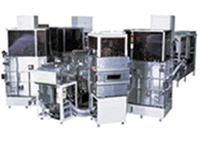To meet OLED display supplies for the next generation iPhone 8, Apple tracked down equipment maker Canon Tokki located in Japanese rice fields next to the city of Mitsuke in Niigata prefecture, reported Bloomberg.
The Japanese equipment manufacturer has a near monopoly in OLED equipment for making the screens, which is able to provide sharp, vibrant displays that use less energy.
The equipment maker is a unit of Canon, with a workforce of 343 employees, it has invested in developing OLED manufacturing equipment for more than two decades.
 |
|
Canon Tokki OLED equipment. (Canon Tokki/LEDinside) |
Despite doubling output this year, Canon Tokki has a growing backlog that challenges Apple’s ability to employ OLED displays in its next generation iPhones, and whether the Cupertino-based company will be able to find additional suppliers. The waiting list for the 10 billion yen (US $85 million) machine is now running to about two years.
"We are doing all we can to increase output and make that wait shorter," said Chief Executive Officer Teruhisa Tsugami, adding that demand from display makers, including Samsung Display, LG Display and Sharp, will remain strong for the next three years.
OLED is the next big goal, and the technology has been included in top-end smartphones for years, including all of Samsung Electronics high-end flagship phones.
Canon Tokki nearly builds all the OLED screen manufacturing equipment in-house, and was founded in 1967 by the current CEO’s father. The company does not disclose production details or earnings figures, and its current annual output capacity is less than 10 units, said unidentified sources familiar with the matter, who declined to be named because the information was confidential.
Canon Tokki’s products are more than just a machine, each is a vacuum production line 100 meters long. Glass panels about the size of a large TV screen, are propelled by robotic arms through several chambers, where RGB pixels are deposited on the surface by evaporating the organic material.
The equipment enables manufacturers to customize their production process like a high-performance supercar, instead of assembling it on a typical product line, said Alberto Moel, a technology analyst at Sanford C. Bernstein & Co commented about Canon Tokki’s machines. "Suddenly everyone wants your car," he added.
One of the challenges is aligning the glass pane with a fine metal mesh that functions as a stencil for the pixels. The Japanese company has been manufacturing OLED equipment since 1993, and the patented mechanism uses camera tracking to achieve a margin of error less than the size of a human red-blood cell.
Precision is critical for display manufacturers to improve yields, noted the Bloomberg report. Even mature LCD technologies that dominate flat-panel TVs and are used in iPhones, will discard a fraction of defective panels. Acquiring acceptable yields with OLEDs is even harder.
Canon Tokki has a headstart in the display industry against rivals including Ulvac and Tokyo Electron, according to Tsugama. The market for small to mid-sized OLED panels will peak to US $18.6 billion in 2018, surpassing similar LCD panels for the first time, according to data compiled by IHS Markit.
"This is a once-in-a-lifetime opportunity for Tokki and they will have the market to themselves for the next two to three years," Moel said.
Apple plans to ship at least one new iPhone with an OLED screen next year, the 10th anniversary of the smartphone's debut, people with knowledge of the matter have said. While Samsung is on track to be the sole supplier, the South Korean company may not be able to make enough due to low yield rates combined with increasing iPhone demand.
Canon Tokki will also play a crucial role for Sharp and Japan Display to reach their OLED manufacturing targets in the near future. Sharp is aiming to begin production by 2018, and has invested 57.4 billion yen in related OLED production facilities after receiving a generous rescue package from Foxconn.
This week Japan Display received 75 billion yen funding from a government backed fund to invest in OLED production.
Foxconn Chairman Terry Guo assured employees after acquiring Sharp’s display unit earlier this year that he had secured an equipment order Canon Tokki's headquarters in Niigata, said a former employee at the meeting.
Other Japanese companies that play key roles in the OLED supply chain include Dai Nippon Printing and Toppan Printing that produce evaporation masks, Nippon Electric Glass and Asahi Glass that make the glass substrate, and Idemitsu Kosan that makes organic compounds.












